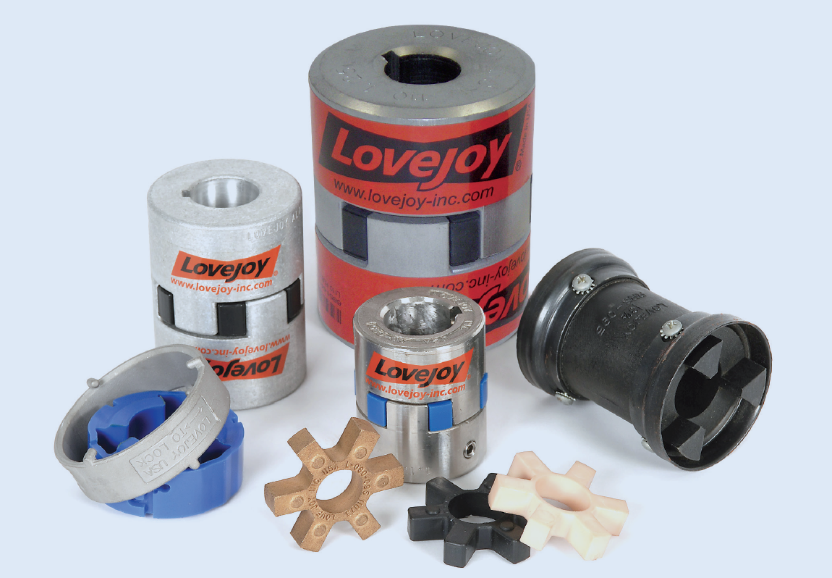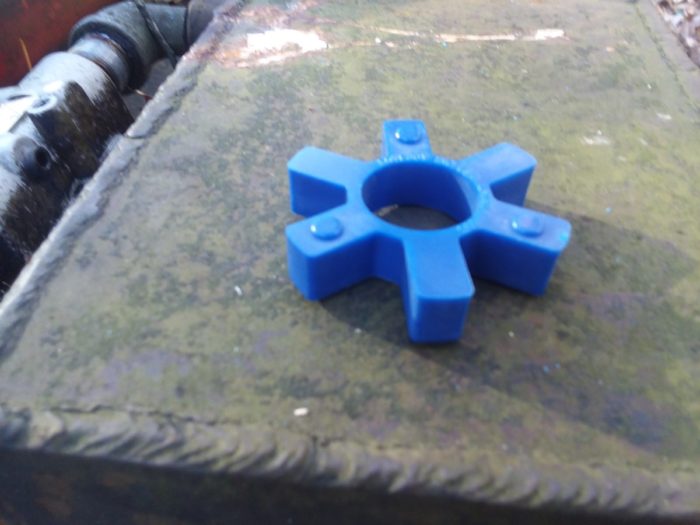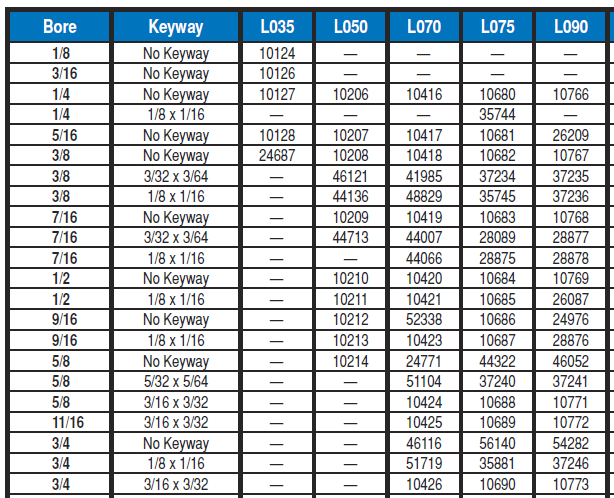
This post is a continuation of a how to determine the torque needed for our coupler. Click Here to view it.
Jaw type shaft couplers are a lifesaver. These wonderful pieces of machinery allow for torque transmission between two different items and account for radial, angular and axial misalignment. It also has built in shock absorption that diffuses impact loads, like from reversing loads, and start up loads.
Jaw shaft couplers do this by having a mechanism, the spider, to connect two jaws. One Jaw connects to each shaft and the spider slips between the jaws. Great reasons to use jaw couplers include the following:
- Allow for some misalignment (let’s face it, it is tough to get shafts to align right!)
- Thousands of options for shaft size, torque transmitted and spider material
- No metal to metal contact
- Resistance to dirt and oils
- Nearly maintenance free
- Smaller sizes are readily available (no 8-12 week lead times). You can even buy them on Amazon.
- Fail-safe. If the spider fails, the jaws will still make contact with each other. There will be metal on metal contact there, so be sure to replace the spider when this happens.
Spider Materials
The spider gets it name from its shape…sort of. Obviously, the legs on it look like a spider except for one thing. Spiders have eight legs not six! Insect may be more appropriate, but spider sounds much cooler.

Selecting the right spider material is imperative. It must be able to handle the torque applied and provide adequate shock absorption.
It is also important to consider operating temperature. Be sure to keep in mind if the local temperature of the coupler will be higher than the ambient temperature.
A general principle when selecting a spider material is that you are trading shock absorption for torque. A rubber material will definitely offer more shock absorption, than bronze, but bronze will handle much more torque. Let’s take a closer look at the most popular materials:
NBR Rubber
- This common material is used in almost all hydraulic and plumbing seals.
- Inexpensive
- Readily available
- Highly flexible
- Oil resistant
- Great shock absorption
- Good temperature range of -40° to 212° F (-40° to 100° C)
Urethane
- Has 50% more torque capacity than NBR
- Good resistance to oil and chemicals
- Good shock absorption
- Operating temperature range of -30° to 160° F
Hytrel
- Flexible
- High torque
- Greater operating temperature range of -60° to 250° F (-51° to 121° C)
- More expensive
Bronze
- Highest torque rating
- Available in oil-impregnated metal
- Very low speed (keep below 250 rpm)
- Very little shock absorption
- Not affected by water, oil, or dirt
- Highest operating temperature range: -40° to 450° F (-40° to 232° C)
Selecting the Spider and Jaws
Continuing from the example in the previous post, we will use the 5 HP engine running at 2500 RPM and came up with 126 in-lb. of torque. Our service factor was determined to be 1.5 bringing our required torque to 190 in-lb.
Sizing the Spider
It is easier to select the spider first and then the jaw set. Looking at the table below, I can choose:
- L095 for NBR
- L090 for Urethane
- L075 for Hytrel or Bronze.
Because Hytrel and bronze are the most expensive and least flexible alternatives (not to mention that the speed is too high for bronze), I will not consider the L75 as viable options.
The choice is now down to NBR and Urethane. If I choose NBR, I will pay more for the jaws, but less for the spider. The main benefit that I see is the urethane has a higher torque rating (216 in-lb.) at the smaller size than the NBR has at the larger size (194 in-lb.). This will lead to increased life of the spider. In fact, it may never need to be replaced.
With all of that said, I will select the L090 with the urethane spider.
We will go ahead and select the actual part numbers we need. Remember, we have determined that the coupling size will be the L90 series. Now it is time to find the spider type that fits our application.
I prefer to use a type with an open center so that the shafts can go into the space that the spider occupies if needed. Looking at the listing we will need to find the Urethane (open center) spider type and then the intersecting column under the L90 coupling size. Where these two meet we find our part number which in this case is 11075.
Real World Update
Since I inherited the log splitter used in this example, the existing coupler was an L90 size, but with a NBR coupler. This was enough to handle the torque without the service factor.
It wore out and you could hear the metal on metal clicking as a clear identifier of the problem. I have replaced it with a urethane L90 coupler. Time will tell if it ever needs to be replaced again.
Selecting the Jaws
Now we can find the jaw part number needed for our application. First off, we need to know what shaft size is appropriate.
Our pump has a 1/2″ bore shaft size, we will want to match this up in the part listing. Looking at the chart, we will find where the L090 series column and the 1/2 bore with keyway intersect to locate the part number 26087.
Notice that we have a keyway on this which is 1/8 wide and 1/16 tall. Normally the height will be one half of the width for the keyway so that a standard square key can fit.
We will do the same for the other shaft which has a 3/4 inch bore size and keyway will 3/16 wide by 3/32 tall. Referencing this size on our chart, we find the L090 column and the part number which will be 10773.
After determining and selecting which parts are needed, we will need to go ahead and place an order for:
- L90 Urethane Spider 11075
- L90 Jaw with 1/2″ keyed – 26087
- L90 Jaw with 3/4″ 3/16 key – 10773
I will mention that a great benefit of Lovejoy couplers is the presence of product distributers on Amazon. This makes the ordering process easier and the shipping faster.
Final Thoughts
Finally, I would strongly recommend applying anti-seize to all parts before assembly in order to prevent rusting. This is a huge help if you ever need to take them apart (at some point you will) and it is nearly impossible to do without breaking parts if rust has occurred.
For example, I recently had to do this on a project and ended up having to cut a gear in half to remove it from the shaft. Make sure you take this simple step to help prevent the hassle of rusted parts. In the end it will help preserve the parts and aid in the process of disassembling if ever needed.
I hope this information has been helpful in the process of selecting the right parts for your own project. The intent of this article is to familiarize you with jaw couplers, be able to calculate the torque and service factors and finally be able to select the jaw size and spider materials right for your application.
Happy designing!
(All images/charts courtesy of Lovejoy Jaw Type Couplings Catalog)





